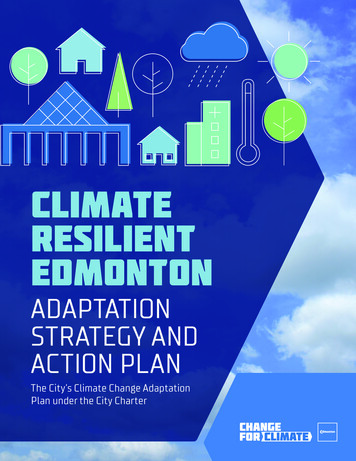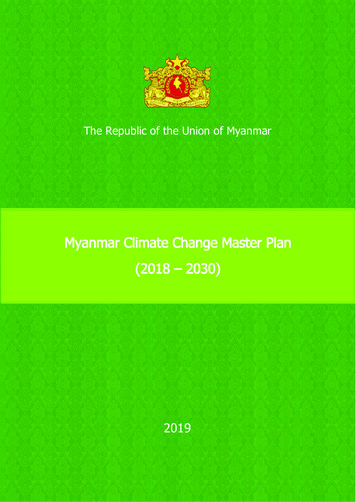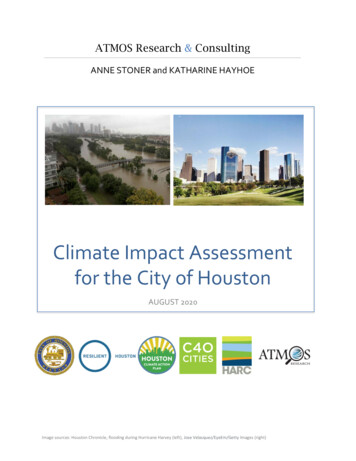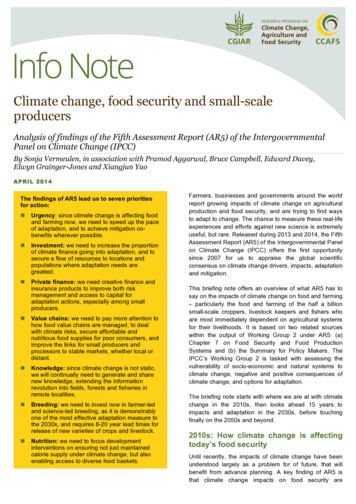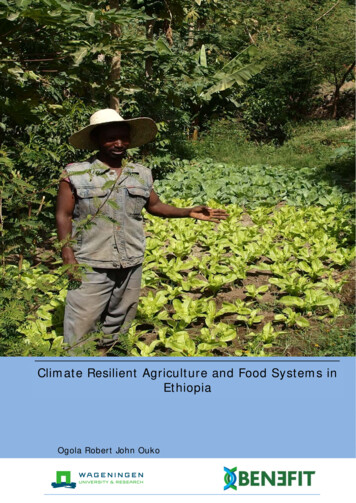
Transcription
Climate Resilient Agriculture and Food Systems inEthiopiaOgola Robert John Ouko
Climate Resilient Agriculture and FoodSystems in EthiopiaOgola Robert John OukoWater Systems and Global Change GroupEnvironmental SciencesWageningen UniversityInternship Report
Ogola J.R.O (2021). Climate Resilient Agriculture and Food Systems in Ethiopia. Wageningen Centre forDevelopment Innovation, Wageningen University & Research. Wageningen. 2021 Wageningen Centre for Development Innovation, part of the Stichting Wageningen Research.P.O. Box 88, 6700 AB Wageningen, The Netherlands. T 31 (0)317 48 68 00, E info.cdi@wur.nl,www.wur.eu/cdi.The Wageningen Centre for Development Innovation uses a Creative Commons Attribution 3.0(Netherlands) licence for its reports.The user may copy, distribute and transmit the work and create derivative works. Third-party materialthat has been used in the work and to which intellectual property rights apply may not be used withoutprior permission of the third party concerned. The user must specify the name as stated by the authoror licence holder of the work, but not in such a way as to give the impression that the work of the useror the way in which the work has been used are being endorsed. The user may not use this work forcommercial purposes.The Wageningen Centre for Development Innovation accepts no liability for any damage arising fromthe use of the results of this research or the application of the recommendations.Photo cover: Irene KoomenClimate Resilient Agriculture and Food Systems in Ethiopia ii
ContentsAcknowledgementsList of abbreviations and acronymsiiiList of Tables and FiguresiiiExecutive Summaryiv1Introduction11.1General and specific objectives of the study21.2The study report structure22Methodology32.1Data Collection32.1.1 Literature review32.232.1.2 Expert interviews3Data Analysis3Study Findings3.15Overview Climate Change Impact on Agriculture and Food Systems Transformation53.1.1 Impact of Climate Change on Agriculture and Food Systems3.253.1.2 Agricultural and Food systems Transformation6Analysis of Key Themes and Programmes Enhancing Climate Resilience63.2.1 CSA Adaptation Strategies73.2.2 Climate information83.2.3 Water Management93.2.4 Soil Health and Fertility113.2.5 Promotion of CSA inputs and technologies123.2.6 Social protection adaptive strategies143.3Policies and Strategies Relevant to Climate Resilient Agriculture and Food Systems3.4Policy Priorities to Improve Climate Resilience and Food Systems.15Stakeholder Mapping and Policy Network for Climate Resilience.16143.543.5.1 Stakeholder map for climate resilience163.5.2 Policy Network and Influence for climate resilience in Ethiopia17Conclusions and Recommendations18References19Appendices22
AcknowledgementsI am grateful for the support of experts from BENEFIT programme and Ethiopian government ministrieswho gave their expert’s opinions. This study was supported and done within the context of the BENEFITpartnership with close supervision from Dr. Irene Koomen. My thanks also go to Wageningen Centre forDevelopment and Innovation (WCDI) fraternity for allowing me to conduct my research internship inamazing organisation, Dr. Dawit Alemu and Dr. Akalu Teshome for facilitating smooth connection withEthiopian Experts.Climate Resilient Agriculture and Food Systems in Ethiopia i
List of abbreviations and acronymsAGRAAlliance for Green Revolution in AfricaATAAgricultural Transformation AgencyBENEFITBilateral Ethiopian Netherlands Efforts for Food, Income and TradeCCAFSClimate Change Agriculture and Food SecurityCSAClimate Smart AgricultureCGIARConsortium of international Agricultural Research CentersEEFCCCEthiopian Environment, Forestry Climate Change CommissionEIAREthiopian Institute of Agricultural ResearchEPAEnvironmental Protection AuthorityDFIDDepartment for International DevelopmentEUEuropean UnionFAOFood and Agriculture OrganizationGoEGovernment of EthiopiaG4AWGeodata for Agriculture and WaterGIZGerman Agency for International CorporationGWPGlobal Water FundIFPRIInternational Food Policy Research InstituteMoAMinistry of AgricultureMoWIEMinistry of Water, irrigation and EnergyMoFEMinistry of Forestry and EnvironmentNAPNational Adaptation PlanNMANational Meteorological AgencyPfRPartners for ResilienceRTIResearch Triangle InstituteSTCsSub-Technical CommitteesSWOTStrength, Weakness, Opportunity and Threats.UNDPUnited Nations Development Programmes.USAIDUnited States Agency for International DevelopmentUNEPUnited Nation Environmental ProgrammeWIWeather ImpactClimate Resilient Agriculture and Food Systems in Ethiopia ii
List of Tables and FiguresList of TablesTable 1:Summary of CSA adaptation practices for climate resilience . 7Table 2: projects and programmes in climate information . 9Table 3: Projects and programmes in water management . 11Table 4: Projects and programmes in soil Health and fertility. . 12Table 5: Projects on the promotion of CSA inputs and technologies. 13Table 6: Ethiopian policies and strategies developed between 2010-2020 on climate resilience. . 15List of FiguresFigure 1: Impacts of Climate change on food systems (Source: climatecouncil.org.au) . 5Figure 2: Framework of climate-resilient agriculture and food systems in Ethiopia. 6Figure 3: Summary of SWOT analyses on climate information . 9Figure 4: Summary of SWOT analyses on water management. 10Figure 5: Summary of SWOT analysis on soil Heath and Fertility . 11Figure 6: (a)Agroecological zones (EAIR, 2008), (b)Soil Moisture Regime of Ethiopia (Chamberlin etal., 2006) . 12Figure 7: Summary of SWOT analysis on promotion of CSA input and technologies . 13Figure 8: Stakeholders map with main areas of focus for climate resilience . 16Figure 9: Influence of stakeholders on policy design in Ethiopia. 17Figure 10: Influence of stakeholders on policy lobby and advocacy to the government . 17Climate Resilient Agriculture and Food Systems in Ethiopia iii
Executive SummaryAgriculture is one of the key sectors driving the economic growth of Ethiopia, however, the sector facesserious food production challenges to feed over 115 million of its population. Due to Ethiopia’s lowinstitutional and economic capacity to build climate resilience for improved agriculture and food systems,the country is facing numerous challenges of climate change. Floods and droughts predominantly causehavoc to Ethiopian agriculture and food systems leading to increased poverty, food insecurity andmalnutrition.This study analyses the current climate change adaptation strategies and policies enhancing climateresilience in Ethiopian agriculture and food systems for Ethiopia. The methodology of the study includesa literature review of information relevant to building climate resilience in agriculture and food systems,in-depth expert interviews and stakeholder network analysis simulation. The study themed four areasof concern to build climate resilience in agriculture and food systems in Ethiopia, these areas includeclimate information, water management, soil health and fertility, promotion of Climate Smart Agriculture(CSA) inputs and technologies as well as the policy concerns around the four themes. A SWOT analysiswas conducted to focus on areas of strength and greatest opportunities.From the SWOT analyses conducted, it became clear that climate information is very important forfarmers to strategically plan their farming activities considering the increased climatic variability thecountry is facing. Currently, a low number of farmers have been reached with tailored weatherinformation services yet there is a huge potential in Ethiopia. The dissemination of climate informationmostly is through project development programmes hence, face lots of uncertainty for continuity afterthe projects period end. For future response, suggestions such as integrating weather models for longterm weather predictions, support for inter-ministry dialogue and liberalization of policy to supportpublic-private partnership are key. Other areas of great concern were the integration of tailored weatheradvisory into the country’s extension systems and capacitating extension agents on climate technologiesinformation use and dissemination since they are new.To build resilient agricultural and food systems, proper soil health and fertility and water managementdetermine the quantity and quality of food production. Currently, due to high degradation, deforestation,the trade-off of crop residue for livestock production and increased high temperatures, the soils areunable to produce to their full potential. Hence concerns on how to improve soil fertility and waterretention capacity to boost production sustainably are encouraged. Consequently, water is a major factorin crop production and is also prioritized by the government of Ethiopia. Being one of the big agenda toincrease water productivity through efficient irrigation systems and management of watershedecosystems, support is much needed to expand irrigation systems and restore watershed for continuedfood production in times of climate change.Promoted mainly by different research institution and NGOs, CSA input and technologies such asimproved crop varieties, small scale irrigation, early warning systems, crop diversification have receivedsupport from the Ministry of Agriculture as some of the approaches to cushion farmers against climateshocks. The study found that the promotion of CSA practices has been affected by inadequate improvedCSA inputs and climate advisory on the technologies packages. The study also indicates greatopportunities for untapped tested CSA technologies for upscaling to enhance climate resilience and foodproduction in Ethiopia.The analysis shows that the major stakeholders promoting climate-resilient agriculture and food systemsin Ethiopia include FAO, UNEP, World Bank, DFID, USAID, CGIAR and EU through sponsoring variousprojects. The government ministries and (inter)national research institutions are also involved throughresearch and advice to farmers and the Federal government. A number of policies and have beendesigned to help Ethiopia mitigate and adapt to climate change for resilience and sustainabledevelopment. Recently, the Government of Ethiopia launched a 10- Year Perspective Development Plan(2021-2013) with the main goal to end overreliance on rainfed agriculture by expanding the country’sirrigation system capacities and encouraging irrigation investments.The study found that Ethiopia has good climate-resilient strategies and policies, however, thegovernment need to mainstream SMART action plans to realize the country’s policy goals. To achievethe strategies goals, the we recommends mainstreaming weather advisory in the national extensionClimate Resilient Agriculture and Food Systems in Ethiopia iv
systems, Policy support to involve private service providers whose inputs are key for the transformationof the climate resilient agricultural systems, support to farmers by subsidizing costs of agriculturalinsurance, climate information, CSÁ promotion and implementations, strengthening capacities ofresearch institutions to develop detailed content periodically to support various platforms, agro-weatherand extension services, and support the government to establish strategic frameworks and plans thataddresses the gaps in policy documents to successfully implementand reduce policy governanceconflicts.Climate Resilient Agriculture and Food Systems in Ethiopia v
1 IntroductionEthiopia's agriculture sector contributes 33.3% of its gross domestic product and employs about 80%of the population (Tesso, 2020). However, the sector remains fragile and vulnerable to climate change,affecting agriculture and food systems in the country. Ethiopia with a population of about 115 million in12020 and forecasted to rise to 120 million by 2030 is putting increasing pressure on resources available(DFID, 2012). Agricultural yields are struggling to keep up with the population increase and climatechange effects. Climate-induced hazards such as droughts, rising temperatures and floods are a majorthreat to the agricultural productivity, food systems and livelihoods of over 65% of the households whoare food insecure and living in poverty (OPHI, 2020; WFP, 2019).The country has experienced recurrent droughts and 11 flooding episodes between 2010 and 2021,2some of which resulted in substantial humanitarian crises . For example, the 2015-16 drought, whichresulted in the worst famine in the country history and left over 10 million people in need of urgent food3relief assistance. According to the 2018 ND-GAIN Index , which summarizes a country's vulnerability toclimate change and its readiness to improve resilience, Ethiopia ranks 157 out of 181 countries, is the20th most vulnerable country, and the 44th least ready country.Due to Ethiopia’s diverse agro-ecological zones across the country, it’s impossible to generalize futureclimate change projections. However, based on the climate change profile of Ethiopia, the country isprojected to face increasing average temperatures of 10C by 2030, and 20C by 2050 (MoFAN, 2018).These climate changes will cause increased uncertainty and variability in seasons and rainfall as well asincreased extreme events in the country. The lowland is predicted to suffer most with prolongeddroughts and increasing temperatures affecting agro-pastoral production systems in the region. Thehighland on the other hand is predicted to suffer from extreme events such as dry spells coupled withirregular and intense rainfall leading to flooding, erosion, storms and overall lower agricultural and foodproduction.Buffering the economy from severe climate shocks and building resilience to climate change-inducedstressors is an urgent matter for Ethiopia. It is with this sense of urgency that the Government ofEthiopia (GoE) took a proactive action through the launch of the Climate Resilient and Green EconomyStrategy (CRGE) in 2011 to address climate change concerns (FDRE, 2011). Another major step is thelaunch of the National Adaptation Plan (NAP) in 2019, which aims to mainstream climate changeadaptation initiatives with ongoing development efforts including the Productive Safety Nets Programme4(PSNP) and Sustainable Land Management Programme (SLMP) (FDRE, 2019). The inclusion of CRGEas one of the cross-cutting elements in the country’s current growth and transformation plan (GTP II)also shows the government’s commitment to addressing climate change-related issues affecting theeconomy and particularly the agriculture sector (FDRE, 2016). The government acknowledges that inthe long-term if climate change is not tackled, the country’s economic growth will be at risk.1234worldometer sters?advanced-search rogram-psnp/Climate Resilient Agriculture and Food Systems in Ethiopia 1
1.1 General and specific objectives of the studyThe general objective of the study was to analyse the current climate change adaptation strategies andpolicies enhancing climate resilience in Ethiopian agriculture and food systems. This was to enable theRAISE-FS project to understand and consider what adaptation changes are necessary to lead thetransformation to a sustainable Ethiopian food system. The study formulated below specific objectives to address the general objective; To give an overview of climate change impact on agriculture and food systems transformationin Ethiopia To explore climate-resilient strategies tested and/or applied in Ethiopia. Identifying programmes and projects geared towards enhancing climate resilience. Identifying unexploited opportunities to improve climate-resilient agriculture and food systems. Reviewing key policies and strategies relevant for the transformation of agriculture and foodsystems. To map and analyse stakeholders’ networks building climate resilience in Ethiopia. Provide recommendations that stem from the analysis.1.2 The study report structureThe structure of this study report is as follows. In chapter 2, a description of the methodology used inthe study is presented. Chapter 3 contains analyses of the current agriculture and food system inEthiopia, programs and projects towards agriculture and food systems, relevant policies and strategiesframeworks in accordance with the specific objectives set and finally mapping and analysis ofstakeholders and policy networks in Ethiopia. In Chapter 4, the study draws conclusions andrecommendations that stem from the analysis.Climate Resilient Agriculture and Food Systems in Ethiopia 2
2 Methodology2.1 Data CollectionThe data collection involved both a desktop literature review and in-depth key experts/informant.2.1.1 Literature reviewThe desktop review was conducted to analyse the current agriculture and food systems situation, identifyprojects enhancing climate resilience and identify key policies and strategies relevant for thetransformation of agriculture and food systems in Ethiopia. This involved sourcing scientific literatureand information from different databases such as google scholar, RefSeek and Scopus. The publicationsand reports were searched using keywords, logical operators, probable titles and filtering techniques.Search terms used included keywords like agricultural transformation, agricultural and food systemresilience, agricultural policy, Ethiopia. These keywords were identified with synonym derived fromliterature, combined into a complete search string, connected with Boolean operators “ÄND” for differentkeywords and “OR” for the synonym of the same keywords. The string was then keyed in selecteddatabases to retrieve the data.The grey literature was also searched to identify evaluation reports, policy documents, strategiesavailable from websites of identified institutions and organizations including portals or donorgovernments. Some of these institutions involved directly or indirectly included the AgriculturalTransformation Agenda (ATA), Ethiopian Institute of Agricultural Research (EIAR), International FoodPolicy Research Institute (IPFRI) and Climate Change Agriculture and Food Security (CCAFS)programme, Food and Agriculture Organization (FAO), United Nations Development Programmes(UNDP) among others.The documents identified were reviewed throughout the study and major issues were further consideredfor interviews with identified experts. Additionally, the information from the reviews helped to informthe design of the questionnaire was used for interviews.2.1.2 Expert interviewsKey national and international experts, and government officials from relevant ministry departmentsand national institutions were interviewed using semi-structured Interviews (questionnaire), theinterviewees are indicated in appendix 1; in appendix 2 the interview guideline is given. Based on termsof reference for the report, the interviews were conducted following the guided discussion. Although tofind more information required, in-depth questions other than the one composed were asked. This wayunexpected issues were covered and specific relevant information gathered (Adams, 2015). The keyexperts and government officials helped to validate information gathered from the literature review,identify the gaps and opportunities to promote and upscale Climate Smart Agriculture (CSA)technologies as well as policies to improve climate resilience and sustainable production among farmersin Ethiopia.2.2 Data AnalysisData was analysed in two ways. Based on the literature review and experts’ interviews, data wascollected and themed into four main areas, i.e. climate information, soil health and fertility, watermanagement as well as promotion of CSA input and practices. A SWOT analysis was then conducted todetermine the strength, weaknesses, opportunities and threats in building climate resilience in Ethiopianagriculture and food systems. SWOT analysis is a technique used to provide answers to questions toClimate Resilient Agriculture and Food Systems in Ethiopia 3
each of the four words whose first letter forms the acronyms. Conducting analysis using the SWOTframework help in focusing activities on areas of strength and greatest opportunities (Nyambi, 2012)Secondly, a network analysis was introduced as a tool to map and understand how different stakeholdersinteract to improve the adaptive capacity to climate change effect. Gelphi tool was used to map andanalyse key stakeholders involved in enhancing climate resilience through resource flows, informationadvice and policy lobbying and advocacy. This helped to examine the role and importance ofstakeholders in a larger network. One network structural attribute of centrality was chosen to explorehow the network structures influence farmer climate resilience. Centrality was chosen to give a measureof the relative position of stakeholder to its network, stakeholder importance and ability to leverageresources and influence decision from other institutions (Huggins, 2000). Using the directed network indegree centrality, out-degree and in-degree which measure the number of flows and relations from onenode to its wider network or wider network to one node were used, respectively. The out-degree in thisstudy was used to reveal the power and social influence of keynote stakeholders and their contributionsto improving resilience. On the other hand, In-degree was used to reveal the power and influence ofstakeholder to influence policy change with the federal government in Ethiopia (Norberg & Cumming,2008). A similar application of this metric has been used to study network attributes influencing valuechains climate resilience (Canevari-Luzardo, 2019).Climate Resilient Agriculture and Food Systems in Ethiopia 4
3 Study Findings3.1 Overview Climate Change Impact on Agriculture and FoodSystems Transformation3.1.1 Impact of Climate Change on Agriculture and Food SystemsThe Ethiopian agriculture sector is the main driver for economic growth. The sector intensification,growth and transformation are largely led by the government through Agricultural Growth Programme(AGP) as part of the GTP (Gebru et al., 2018). The sector is dominated by rainfed agriculture andsmallholder farmers who produce 96% of the annual total gross agricultural output (Evangelista et al.,2013; Jirata et al., 2016). Since the 1980s, rainfall has become erratic in Ethiopia as a result of climatechange causing recurring El Nino and La Nina episodes (Aragie, 2013; DFID, 2012). This has caused theclimate to become hotter and wetter caused by increasing average temperatures, droughts and floodingrespectively, thus, leading to reduced yields and increased crop failures. During the period 1991-2008,Ethiopia lost a cumulative amount in the range of 13-40% of its original level of agricultural output dueto climate change making it more vulnerable to produce efficient food for the growing population (Aragie,2013; Bekele et al., 2020). Future climate change could reduce Ethiopia’s GDP by 8-10% in 2050 (Bekeleet al., 2020; USAID, 2020). The climate change effects also impact negatively on the country’s fooddistribution, farm incomes, food prices, imbalance in imports and exports, unemployment to many theactors involved in agriculture (see figure 1 for an overview of potential impacts of climate change).Increasing climate change effects continue to pose a high risk to food insecurity for the rapidly growingEthiopian population leading to increased economic pressure, rural to urban migration, more debts tothe struggling Ethiopian economy due to more importation and increased nutritional problems.Figure 1: Impacts of Climate change on food systems (Source: climatecouncil.org.au)Climate Resilient Agriculture and Food Systems in Ethiopia 5
3.1.2 Agricultural and Food systems TransformationEthiopian agriculture is on a transformational trajectory from traditional systems to modern systems tobecome more efficient and sustainable for food production following the intensification of the agriculturalsystems. The GoE is putting efforts to improve agricultural productivity and its resilience to climatechange effects through various development and transformation programmes, advocating for climatesmart adaptation strategies and enabling policies. As one of the steps to build a green economy,agriculture and forestry which contributes to 87% of the emission are given priority with major structuraland policy changes (FDRE-CRGE, 2011; Minten et al., 2018). This is to ensure the country reduces itsemission by 60% per year for low carbon economic development, abate land degradation, reduce theimpacts of climate change and improve the livelihoods of rural households. Moreover, climate-smartagricultural practices and sustainable land management programmes are the focus of implementationin the agricultural sector (Hin & Mekonen, 2019). As an example, linking efforts to improve waterproductivity through water harvesting and drip irrigation is one way to strengthen the resilience ofagricultural systems for the production of vegetables, cereals and legumes which is beneficial to foodsystems and the environment.Consequently, the transformation of food systems in Ethiopia is being influenced by population growth,urbanization, infrastructural development income growth (Minten et al., 2018). The notable changes inthe diet include a decline in the relative share of cereals and a rise in high-value chain products such asfruits and animal-sourced foods (Minten et al., 2020). Additionally, major changes have been noted inthe supply chain such increased reliance on the market products by consumers. Hence, developing aresilient and sustainable food systems to meet such market demands is very important for Ethiopia.3.2 Analysis of Key Themes and Programmes EnhancingClimate ResilienceTo improve climate resilience, four main areas of climate information, water management, soil healthand fertility as well as promotion of CSA input and Technologies are key (Figure 2). The study alsolooked at the policies environment around these themes (see section 3.3). In this section, the studygives an analysis of the adaptation practices per theme, their benefits and limitation and/or trade-offs.Additionally, using SWOT analysis which incorporates information both literature and experts, the studydetermined the strength, weakness, opportunities and threats per theme for further improvement inbuilding farmer climate resilience. There are also various projects and programmes working in differentregions of Ethiopia including Oromia, Amhara, Tigray and Southern Nations, National and People’sRepublic (SNNPR) to improve farmers’ climate resilience.Figure 2: Framework of climate-resilient agriculture and food systems in Ethiopia.Climate Resilient Agriculture and Food Systems in Ethiopia 6
Two major adaptation programmes strategies are currently being implemented to enhance climateresilience in agriculture and food systems in Ethiopia. These entailed climate-smart agriculture strategiesincluding Sustainable Land Management programme and the Productive Safety Nets Programme.3.2.1 CSA Adaptation StrategiesClimate-smart agriculture is promoted as one of the approaches that help in building a triple win forimproving farmer productivity, resilience and mitigate greenhouse gas emissions, thus, promoted asenvironmental friendly (Lipper et al., 2014; McCarthy et al., 2011; Nciizah & Wakindiki, 2015). CSA isan integrated approach to managing landscapes in croplands, livestock, fisheries and forestry to address5the interlinked challenges of food security and climate change .Adoption of climate-smart agriculture practices such as agroforestry, integrated soil conservationmanagement, water management systems, crop diversification are important adaptation strategies forsmallholder farming systems in areas with high rainfall variability (Arslan et al., 2014; Schoeneberger,2009; Teklewold et al., 2019; Thorlakson & Neufeldt, 2012). Crop switching was also considered as oneof the key adaptation strategies identified (Tessema et al., 2019). CSA strategies have been identifiedto play a key role in improving food systems through reducing food insecurity, addressing malnutrition,food misdistribution as well as the relationship between agriculture and poverty in Ethiopia (Kebeda etal., 2019). Table 1 shows a summary of the key CSA strategies and practices being tested and promotedto farmers, their benefits and Limitation/trade-offs in improving farmer climate resilience in Ethiopia.Table 1:Summary of CSA adaptation practices for climate resilienceClimateCSA PracticesBenefitsLimitation/ Trade-ResilienceReferenceoffsThemeClimateEarly warning systems such asIncrease farmers’Expensive to(Drechsler & Soer,Informationimproved weather information,preparedness and earlyresource poor2016; Ewbank et al.,pest and disease monitoring.planning for responsefarmers2019)strategies.Lack of long-termReduce farmer yieldearly warninglosses for climate risks.Systems informationto farmers.Improved income.IntegratedEfficient water utilization,Improve yields, incomeOpen structures are(Adela et al., 2019;WaterMulching
3.2 Analysis of Key Themes and Programmes Enhancing Climate Resilience 6 3.2.1 CSA Adaptation Strategies 7 3.2.2 Climate information 8 3.2.3 Water Management 9 3.2.4 Soil Health and Fertility 11 3.2.5 Promotion of CSA inputs and technologies 12 3.2.6 Social protection adaptive strategies 14

